German Schnitzel (Schweineschnitzel)
This post may contain affiliate links. See my disclosure policy.
This traditional German Schnitzel recipe, known as Schweineschnitzel, is just the way you know and love it from your favorite German restaurants! Made the way I learned it from my Mutti and Oma, this tutorial includes all the tips and tricks are included for making the absolute PERFECT Schnitzel!
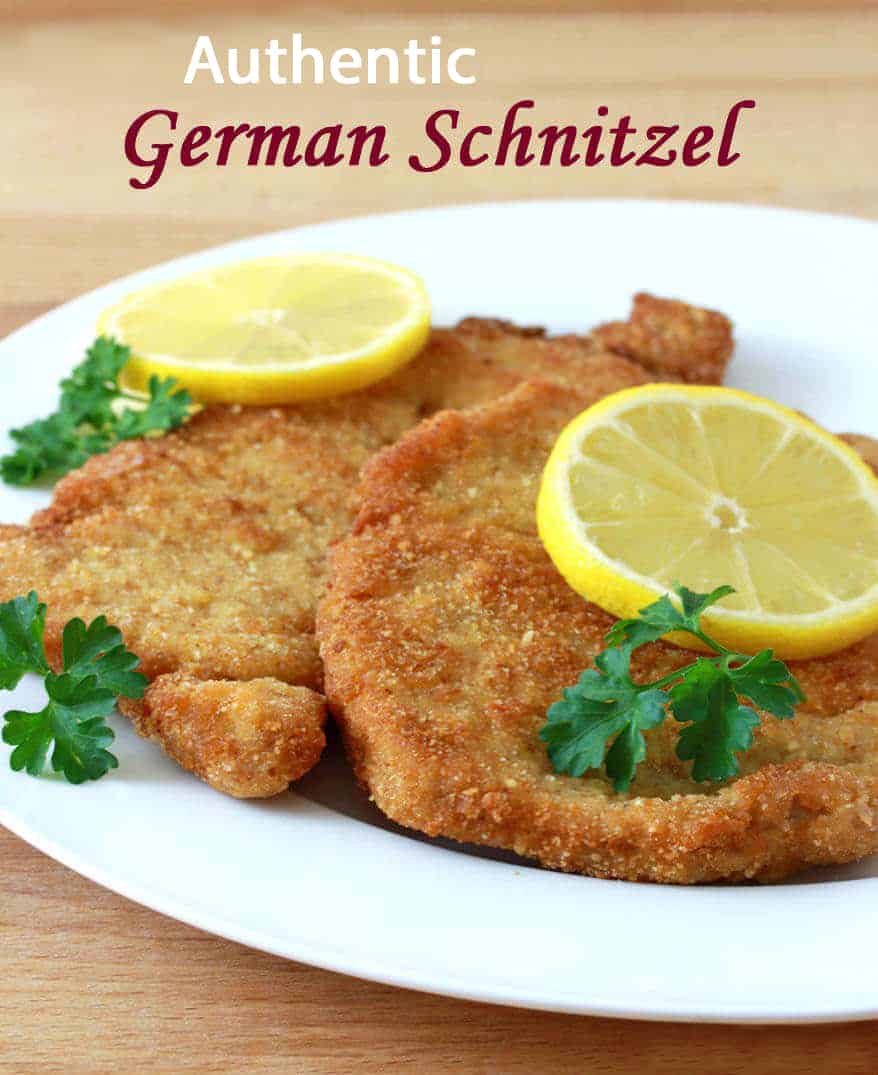
Being from Germany and as much as I love to cook, it would be unforgivably inexcusable, a total outrage, if I didn’t know how to make Schnitzel! After all, it’s one of the most quintessential German dishes. Practically every tourist to Germany has had Schnitzel and most fall in love with it.
Schnitzel vs. Wienerschnitzel: What’s the Difference?
Many people associate Schnitzel with Wienerschnitzel. However, “Wienerschnitzel” is actually a geographically protected term in Germany and Austria and can only be made with veal. German Schnitzel is prepared the same way as Austrian Wienerschnitzel, but the difference is that German Schnitzel, known as Schweineschnitzel, is made with pork instead of veal. As for where the Schnitzel originally came from…the technique of breading and frying thin cuts of meat is attributed to the Romans from around 1 BC. Another factual tidbit: Austrians will be the first to admit that Wienerschnitzel doesn’t come from Wien (Vienna).
But whether it’s Schweineschnitzel or Wienerschnitzel, when it’s perfectly breaded, perfectly fried, and perfectly crispy, practically everyone loves a good Schnitzel! And now you can make it – perfectly – in your own kitchen!
Variations
The most popular variations of Schnitzel are Jägerschnitzel (“hunter schnitzel”) which is served with mushroom gravy, Zigeunerschnitzel (“gypsy schnitzel”), served with a zesty bell pepper sauce, and Rahmschnitzel (“cream schnitzel”) served with a delicious creamy Rahm Sauce. All three are commonly found in German restaurants and are all positively delicious. If you love Schnitzel you have to try them all!
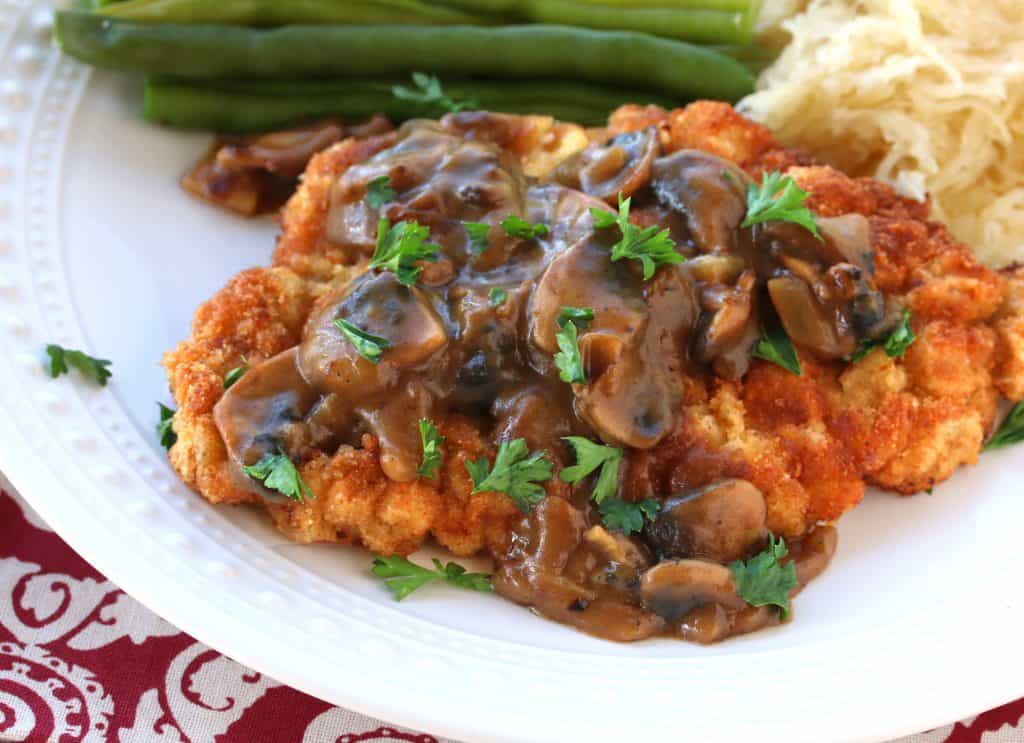
Schnitzel Recipe
Let’s get started!
Throughout the pictured recipe steps below, I’m going to share some tips and tricks with you that are important for achieving perfect results – just like the kind you get at a German restaurant.
Pro Tip 1: Pound the meat very thin, no more than 1/4 inch thick. The reason this is important is because you’ll need to fry it at high heat for a short period of time to get that perfect crispy crust without leaving the middle of the meat raw.
The easiest way to pound the pork is to lay it between two pieces of plastic wrap. Be sure to pound them using the flat side of a meat mallet. Lightly sprinkle each side with salt and pepper. Dip the pork into the flour, coating all sides.
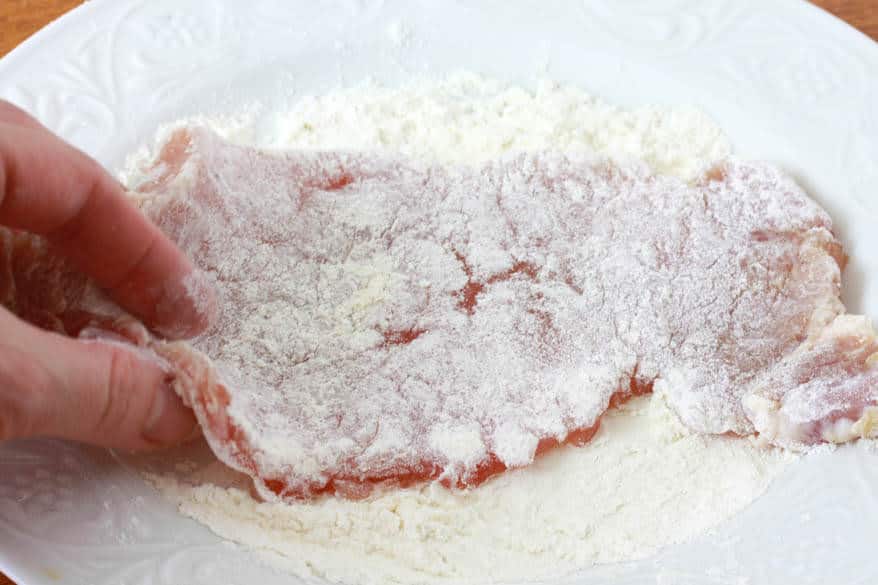
Next dip the pork into the egg mixture, coating all sides.
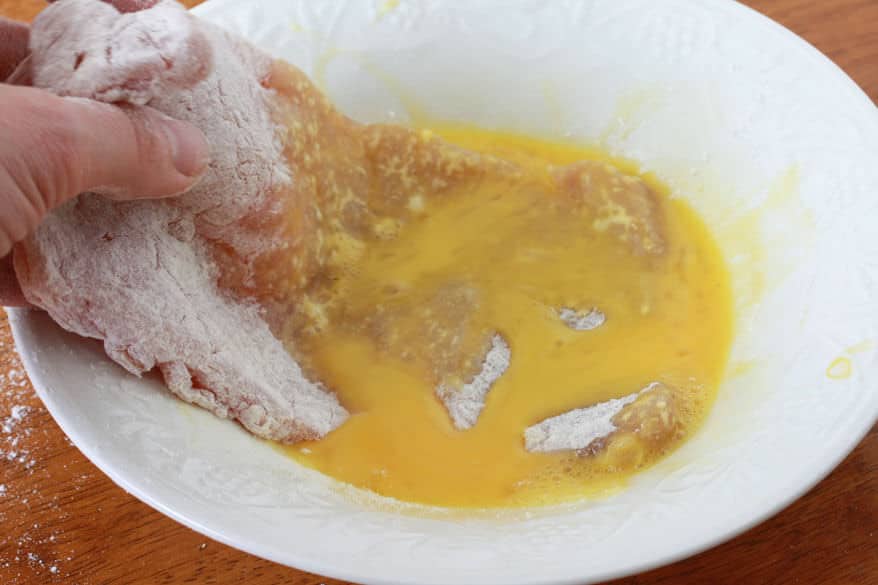
Then coat the pork with the breadcrumbs.
Pro Tip 2: Don’t press the breadcrumbs into the meat. Just softly coat the pork on both sides and all edges, and then gently shake off any excess.
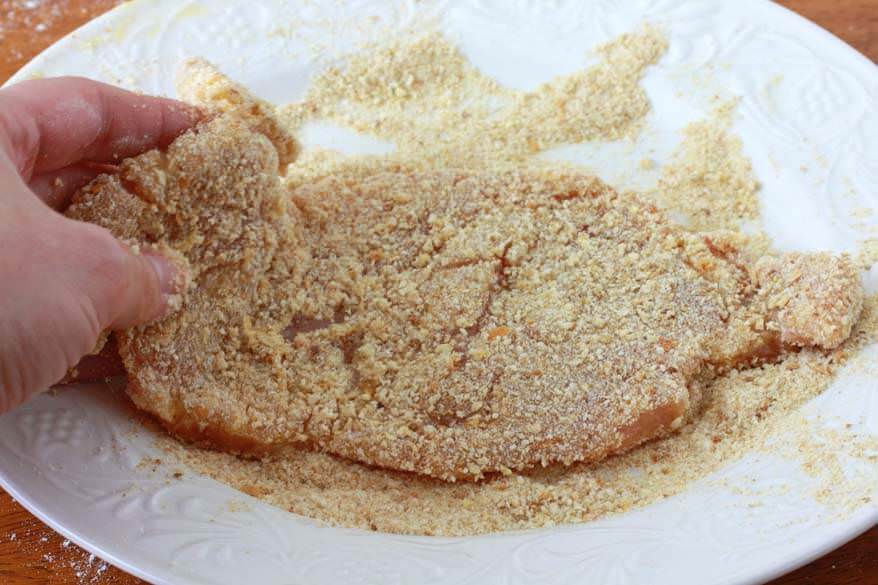
Pro Tip 3: Fry the Schnitzel immediately. Don’t let them sit in coating or the end result won’t be as crispy. You don’t need a ton of oil, but you need enough so that the Schnitzel can “swim”.
Pro Tip 4: Make sure the oil is hot enough – but not too hot. It should be around 330ºF – test it with a candy thermometer. If it’s too hot, the crust will burn before the meat is done. If it isn’t hot enough, you’ll end up with a soggy coating. When the oil is hot enough it will actually penetrate the coating less and you’ll end up with a crispy “dry” coating instead of an overly oily one. The result will be a beautifully crispy coating with a tender and juicy interior, and that’s exactly what we want.
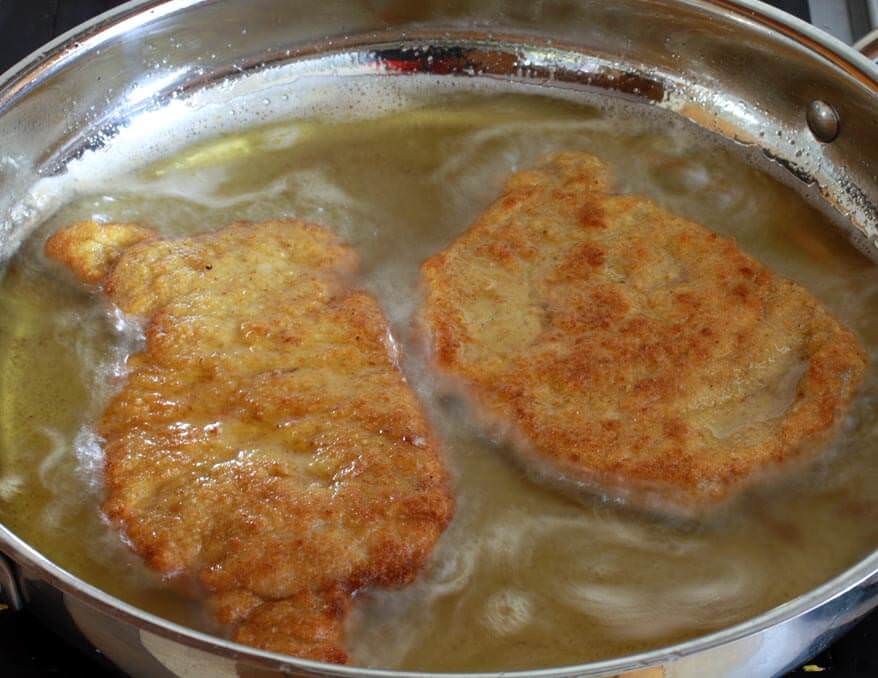
Remove the Schnitzel from the fry pan and place them briefly on a plate lined with paper towels. Transfer them to serving plates and garnish with slices of lemon and fresh parsley sprigs.
Serve immediately with French fries, Spätzle, or German potato salad and a fresh leafy green salad. See blog post below for more serving recommendations.
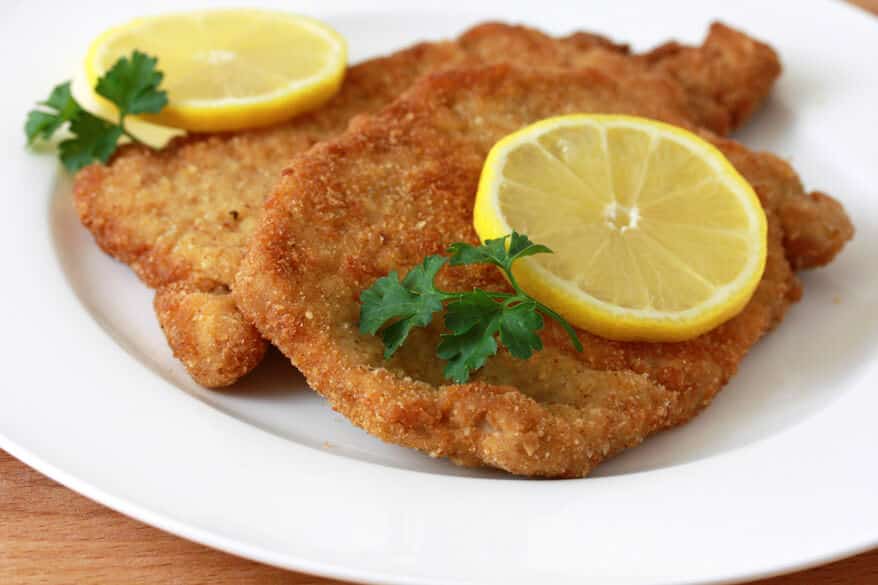
What to Serve with Schnitzel
In Germany, Schnitzel is commonly served with any of the following:
- Pommes (French fries); see my Oven Baked French Fries or Baked Potato Wedges.
- Spaetzle and gravy
- German Potato Salad
- Creamy German Cucumber Salad
- Krautsalat
- A leafy green salad
Additional serving options include mashed or roasted potatoes, Sauerkraut, Rotkohl, and roasted or steamed veggies. And if you want to pair it with some non-German sides you can serve it with classics like Creamy Coleslaw, Macaroni Salad, Classic Potato Salad, Baked Potato Wedges, Baked Beans, or Broccoli Salad.
Enjoy!

For more authentic German recipes be sure to try my:
- Sauerbraten
- Rouladen
- Schweinshaxe
- Königsberger Klopse
- Currywurst
- Käsespätzle
- Kartoffelpuffer
- Senfbraten
- Jägerschnitzel
- Maultaschen
- German Potato Soup
- Frikadellen
- German Sauerkraut Soup
Save This Recipe

Traditional German Schnitzel (Schweineschnitzel)
Ingredients
- 4 boneless pork steaks or chops, (to make Austrian Wienerschnitzel use thin veal cutlets)
- salt and freshly ground black pepper
- 1/2 cup all-purpose flour combined with 1 teaspoon salt
- 2 large eggs, lightly beaten
- 3/4 cup plain breadcrumbs
- Oil for frying (use a neutral-tasting oil with a high smoke point)
Instructions
- Place the pork chops between two sheets of plastic wrap and pound them until just 1/4 inch thick with the flat side of a meat tenderizer. Lightly season both sides with salt and freshly ground black pepper.
- Place the flour mixture, egg, and breadcrumbs in 3 separate shallow bowls. Dip the chops in the flour, the egg, and the breadcrumbs, coating both sides and all edges at each stage. Be careful not to press the breadcrumbs into the meat. Gently shake off the excess crumbs. Don't let the schnitzel sit in the coating or they will not be as crispy once fried – fry immediately.Make sure the cooking oil is hot enough at this point (about 330 degrees F) as you don't want the Schnitzel to sit around in the coating before frying. Use enough oil so that the Schnitzels "swim" in it.Fry the Schnitzel for about 2-3 minutes on both sides until a deep golden brown. Transfer briefly to a plate lined with paper towels.
- Serve immediately with slices of fresh lemon and parsley sprigs. Serve with French fries, Spätzle or German potato salad, and a fresh leafy green salad.
Video
Nutrition
Originally published on The Daring Gourmet March 12, 2014




















Hi Kimberly,
I’m cooking your Schnitzel tonite, but I”ve notice in one statement you say to stand after crumbing, then cook start away.
I like to put in frig for awhile, should I do this.
Hi Sue, I don’t think I said anywhere to let it sit. In the pictured instructions and in Step 3 I emphasize the importance of frying the Schnitzel immediately after breading in order to achieve a crispy crust. If you’ve already refrigerated it, don’t despair, it will still taste wonderful. Happy cooking and enjoy!
It has been over 30 years since the German Delicatessen on Robson Strasse in Vancouver, B.C. Canada, closed its doors. They made a schnitzel sandwich that I have been looking for ever since. Nothing has come close after travelling the world. Yours looks very similar and I will give it a try. Will let you know!!!
Please do, Mineo! There’s nothing complicated about making a good Schnitzel. The process is very basic but a few tips – mentioned in the post – need to be followed to get the right results. Happy cooking!
I’m so glad to find your site. I’m from German ancestors and treasure the recipes from my grandparents. I’m looking for a recipe my grandmother called apple dumplings and dip. The “dip” was made with milk and sugar and I’m not sure what else do you know this recipe? I would appreciate any help you could give. We also love the schnitzel. Yum to all German food.
Hi, Dee, I’m happy you found my site, too! The recipe that comes to mind that are Apfelkrapfen. Give that a “google” and see if that’s what you’re looking for, you’ll see several recipe options. I’m not sure what the dip part is. These are generally just eaten as is. I would imagine the dip part was your grandmother’s own touch.
I grew up in Stuttgart and I love German cooking. Schnitzel is one of my favorites.
That’s great! Mine, too :)
Made this today and added a twist…topped the schnitzel with lemon slices and encrusted goat cheese medallions. Sides were fresh green beans with garlic and sea salt and roasted new potatoes. This dinner is a winner. Definite hit with the family. Make sure to get the oil the right temperature.
That sounds yummy! And yes, oil temperature is crucial. Thanks for the feedback!
Love your schnitzel recipe. Can’t wait to try the sauce recipes
Thanks so much, Debby! Happy cooking!
So glad I found this! I turned it into a sandwich on a pretzel roll with some Gulden’s mustard for my family to enjoy. A friend of mine that is heavily involved in our German Heritage society suggested the use of ground up corn flakes versus bread crumbs. I may try it that way next.
Schnitzel sandwiches are fabulous, Andrew! Cornflakes are definitely not traditional but as I always say, the most important thing is that it tastes good!
My Grandmother (from Germany hardly spoke english) would use graded parmesan cheese in her breading and never used flour. Do you know if this is traditional from some part of Germany or just her own twist? It was delicious!! And she always made a gravy using the same oil/butter from the frying pan with white wine, lemon, milk and flour. Is this traditional as well? or just another twist? Honestly, her Schnitzel and Red cabbage was the best I have ever had including the expensive German restaurants I have been to.
Hi Karl, the Parmesan and wine-lemon sauce are not traditional ways of making Schnitzel in any region of Germany, but it sure sounds delicious! What she made sounds more Italian than German influenced (which is actually where the concept of pounding, breading and frying thin cuts of meats originated). I hope you were able to get her recipe – great family recipes are treasures. If not, I may need to add it to my (growing to the point of over-flowing) “Make a Request” list, because it sounds too good not to make! :) That recipe would lend itself especially well to chicken.
Karl, not sure if you’ll see this, but here’s hoping. When you mentioned the Schnitzel coated in parmesan cheese it kind of brought to mind Kasehanchen (sorry, my laptop can’t manage umlauts). If you want to reproduce your grandmother’s recipe, you might want to start there.
Hi Steve:
Tip: anytime you need an Umlaut, substitute it with the letter “e” after the vowel ( a, o, u )
Perfectly correct to do so.